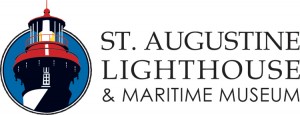The newly re-branded St. Augustine Lighthouse & Maritime Museum aims to enhance its maritime research and education programs to benefit residents, visitors, members and donors.
ST. AUGUSTINE, FLA. – For nearly three decades, the nonprofit St. Augustine Lighthouse has been known internationally as a leader in historic preservation. But under the new moniker of St. Augustine Lighthouse & Maritime Museum, the Smithsonian Affiliate organization aims to enhance its reputation in the field of maritime history and research as well.
“Maritime history plays a foundational role in the story of the lighthouse, as well as the greater story of St. Augustine,” said Executive Director Kathy A. Fleming. “Our mission has always been to tell the stories behind the Nation’s Oldest Port and that hasn’t changed. But with the new name and logo we can better convey to the public that we are much more than just a lighthouse.”
The new brand is one of many enhancements coming to the museum in the next year.
In the spring of 2016, the museum will be launching a new exhibition entitled “Wrecked” to tell the story of a Revolutionary War-era shipwreck off St. Augustine’s coast. Utilizing artifacts conserved at the Museum, the exhibit will not only shed light on the tragedy behind the New Year’s Eve 1782 shipwreck, but also how Lighthouse archaeologists were able to find, document and recover pieces of this wreck.
In order to continue researching and conserving St. Augustine shipwrecks, the Museum will also be breaking ground on a new 2,500 square foot Maritime Archaeology & Education Center. This new addition will provide the first handicap-accessible exhibit space for the museum as well an opportunity for new public education programs that give visitors an exclusive look at archaeology and conservation in action.
The new exhibit will also introduce Star Waters, an illustrated underwater archaeologist who will teach the more than 43,000 school children who attend the Museum annually about the science, technology, engineering and mathematics behind shipwreck research.
A capital campaign is underway to raise the funds needed for the new center. With nearly $2 million raised to date, the campaign is closing in on the final $500,000 needed to reach completion. The funds already raised include grants and appropriations from the State of Florida as well as contributions from corporations and individual donors.
The campaign will not only provide for the new center, but also for the restoration of the World War II-era U.S. Coast Guard Barracks that are currently used as headquarters for the Museum’s maritime archaeology program. Once the offices are transferred to the new center, the Museum plans to restore the barracks for a new exhibition.
“We are embracing more opportunities to keep alive maritime history in St. Augustine while also providing enhanced experiences for our visitors,” said Theresa Floyd, Chairman of the Museum’s Board of Trustees. “It’s an exciting time for the museum, and for the community, because we wouldn’t have any of these opportunities if it wasn’t for the support we have received, starting with the Junior Service League’s restoration of the Light Station in the 1980’s.”
The St. Augustine Lighthouse & Maritime Museum is open seven days a week from 9:00 a.m. to 6:00 p.m. Tickets, tours, memberships and details on how to become part of the new Maritime Archaeology and Education Center are available by phone at (904) 829-0745 or online at www.staugustinelighthouse.org.
###
ABOUT THE ST. AUGUSTINE LIGHTHOUSE & MARITIME MUSEUM:
A pivotal navigation tool and unique landmark of St. Augustine, the St. Augustine Light Station is host to centuries of history. Through interactive exhibits, guided tours and maritime research, the 501(c)3 nonprofit St. Augustine Lighthouse & Maritime Museum is on a mission to discover, preserve, present and keep alive the stories of the Nation’s Oldest Port sm as symbolized by our working lighthouse. We are the parent organization to the Lighthouse Archaeological Maritime Program (LAMP)
and an affiliate of the Smithsonian Institution.


